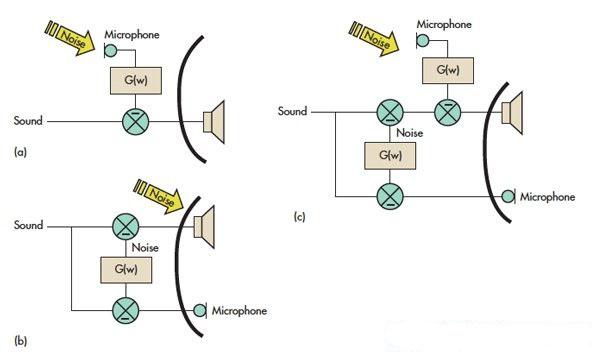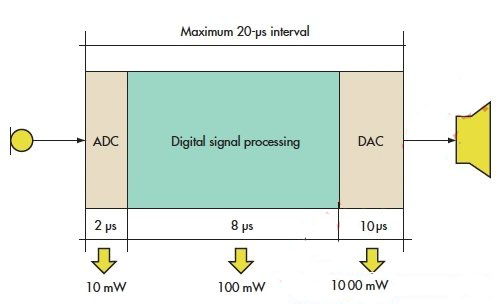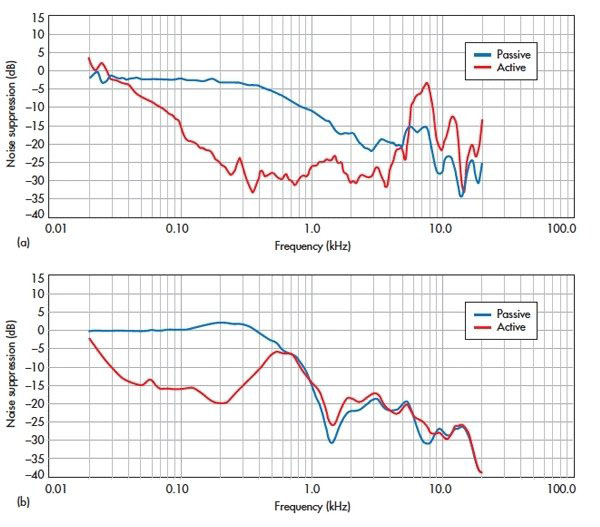Up to 30% of hearing loss in adults may be due to the effects of noise. One of the major effects of hearing loss is the inability to selectively hear content in a noisy background. Noise-cancelling headphones can help save our hearing and allow us to enjoy clearer phone calls, quieter and more peaceful flights, and an overall higher standard of living.
"Passive" noise reduction uses earplugs or earmuffs made of plastic, foam, silicone rubber, or other materials to mechanically isolate the ear from the environment. Depending on the various materials used, passive noise reduction can only have an impact on sounds above 500Hz. Active noise cancellation (ANC) technology is effective for frequencies as low as 20Hz and as high as thousands of Hz. "Active" noise reduction solutions fill a gap that standard passive noise reduction solutions cannot fill.
Active noise cancellation uses the sound produced by the speaker to reduce other sounds that reach the ear. There are two design options for detecting unwanted sound: expose the microphone to the noise and isolate it from the speaker; Or place the microphone as close to the speaker as possible (Figure 1).

Both feedforward and feedback methods can be used together in the same headset (c).
With the feedforward method, if the sound isolation between the speaker and the feedforward microphone is good enough, it will not affect the playback path. This is a big advantage when the noise-cancelling feature is turned off or the battery is running low, leaving the headset operating in passive mode. The music playback is still good. The feedforward topology also makes it easy to create a "hearing aid" mode that amplifies the immediate sound environment, eliminating the need to remove headphones and listen to someone speak.
Feedforward design
With the feedforward topology, designers can perform an acoustic analysis of the headset to determine how the noise changes in frequency, phase, and amplitude as it reaches the ear. The transfer function G (w) can then be modeled electrically and plugged in between the microphone and the speaker.
Feedforward designs are often affected by directional problems, so the microphone must be omnidirectional. Similarly, noise channels cannot be mechanically concentrated. Because the microphone must pick up this noise before it reaches the ear, parallel sound paths must be minimized.
Feedback design
The feedback topology acts according to the actual noise on the ear and, by definition, represents the noise more accurately than the simulation effects used by the feedforward structure. However, the response speed of the system constrains the performance. Special care should be taken when defining transfer functions to avoid introducing instabilities, such as positive feedback.
The feedback design subtracts the playback of the microphone. The resulting signal represents noise around the ear. Using transfer functions, unwanted sounds can be eliminated using signals with phase shifts.
The ideal headset for feedback active noise cancellation will achieve zero latency between the speaker and the microphone that takes the speaker output. This is not possible, because then the speakers and microphones would need to share the same acoustic center. From a physical point of view, this will not be possible. What can be done is to place the microphone as close to the speaker film as possible to reduce propagation delay.
Because the microphone cannot distinguish between noise and playback in feedback headphones, headphones using feedback design usually have some signal distortion. To overcome this problem, a common approach is to add equalization circuits to the playback path to ensure that the sound is the same whether active noise reduction is activated or not.
The feedforward and feedback designs can also be combined in the same headset. This can take advantage of the advantages of both approaches, but can also add complexity and additional cost to the design (need to evaluate trade-offs).
Practical design considerations
The biggest challenge with feedforward solutions is to ensure that the environment around the user's ear is controlled. Since the shape and size of a user's ear varies from person to person, the fit of the headset will vary. If you want to achieve the best noise reduction effect, you need different transfer functions to match these different physical characteristics.
This means that when the headset is designed in a feedforward manner, the headset must be suitable for everyone or must be designed to ensure that differences between different people have minimal impact on the transfer function. The controlled leakage path in the feedforward headset can meet this need.
When considering a feedback design, the main issues are where to place the microphone and how to ensure that acoustic properties are controlled over the entire frequency range. It's subtle, but it's not uncharted territory. Many of the patents relate to research into microphone position and front and rear cavity size/proportions.
In the design tradeoff, the audio response is usually given priority, and the active noise reduction performance can match very well. In these cases, the active noise reduction characteristics are usually limited by frequency bandwidth, but can achieve sufficient or even significant noise reduction levels. This method can still ensure the sound quality of the headset even when the battery runs out.
Another approach is to prioritize active noise cancellation performance, where audio response must be adjusted to ensure sound. In this way, the headset needs to be kept powered at all times, or it must employ some internal passive equalization to produce a "pleasant" sound.
Analog to digital
Designers can choose between digital or analog signal processing methods. Traditional digital solutions rely primarily on prediction and can only achieve noise reduction for "steady state" noise, such as constant engine noise or other constant frequency noise.
Active noise-cancelling headphones must minimize latency to cope with uneven noise. The distance between the microphone and the speaker is usually 0.7cm, which corresponds to a sound propagation delay of 20μs. For digital implementations, analog-to-digital conversion, signal processing, and digital-to-analog conversion are also only 20μs apart (Figure 2).

Figure 2: At a distance of 0.7cm from microphone to speaker, the propagation delay of the signal chain does not exceed 20μs.
Typical power consumption for standard 150MIPS, 24-bit DSPS, analog-to-digital converters (ADCs), and digital-to-analog converters (Dacs) that meet timing requirements is about 113mW. In contrast, analog applications with similar (if not better) performance, such as the AS3400 from Austrian Microelectronics (AMS), consume less than 10mW. Due to battery life considerations, the industry generally prefers analog solutions.
On the other hand, the development of digital solutions has become more precise and software-oriented. And designers will be able to more easily implement features like equalization, bass enhancement, and surround sound - at the cost of extra computing and more power consumption, of course.
While simulation solutions are more experiential and rely on a lot of existing electro-acoustic engineering expertise, this will give designers who can apply that expertise another important advantage that goes beyond battery life, size, and cost: immediate response.
Noise reduction level
Above 1 or 2kHz, each headset exhibits some form of passive noise reduction because the insulation blocks ambient noise from entering the ear. Similarly, noise isolation of 20 to 30dB is usually higher than thousands of Hertz. A good noise-canceling headset has a passive noise filtering function, which can filter the noise to a very low frequency and achieve noise isolation of 5~30dB. Headphones bring peace and quiet even without power.
However, there is a downside to good passive noise reduction: a phenomenon known as occlusion. The best example is sticking your fingers in your ears and talking. Because sound is transmitted through the bone structure of the chin and nose, the experiencer will hear their own voice dull and distorted.
This phenomenon often causes users to raise their voice (or even yell) during a conversation, which is both indiscreet and unpleasant. In addition to removing headphones or earbuds during a conversation, techniques such as sidetone can be employed - the sound is picked up by a separate microphone and played back slightly dimmed.
An unexpected advantage of active noise reduction is its ability to replace the need for high passive filtering at lower frequencies, such as voice bands. Since the user can turn active noise cancellation on or off by controlling the switch, it will be a great convenience when a seat mate on the plane passes the service car in the hope that it will stop the flight attendant.
The feedforward scheme has a sweet spot: a narrow frequency band that maximizes noise reduction performance (Figure 3a). In addition, feedforward schemes can achieve noise reduction in a wide spectrum, typically up to 4 or 5kHz.
Feedback active noise reduction tends to be more uniform across its frequency band (Figure 3b). However, the frequency bands under consideration are usually limited to about 1kHz. This limitation depends on the need for stability to ensure that different people or different headphone pressures do not change enough of the transfer function into positive feedback to cause oscillations. Noise reduction up to 20dB and 1kHz bandwidths is common for feedback designs.
The hybrid design combines the advantages of both topologies while minimizing their disadvantages (Figure 3c).

Design case
During the product concept phase, OEM engineers must evaluate all trade-offs and determine whether the product will choose feedforward, feedback, or hybrid active noise reduction solutions, as well as the materials required for the mechanical design.
The next step is to define the shape, size, and fit of the headset. Active noise reduction device suppliers can advise on the location of the microphone, vent holes, and other characteristics related to the acoustic structure of the headset. The active noise reduction chip integrates all the major functions and provides the necessary performance. The AS34x0 from Austrian Microelectronics has everything you need for a feedforward design (Figure 4).

Figure 4: Feedforward schemes (a) typically have a narrow frequency band where noise reduction performance can be maximized. Sweet spots over 25dB and bandwidths up to 4kHz are common.
Feedback active noise reduction (b) is flatter. Hybrid design (c) combines the best of both designs.
Next in the prototyping phase, the headset developers turn the 3D model into an electroacoustic solution. In this phase, OEM engineers make reasonable modifications to the sound of the headset, and chip suppliers can use simulation tools and development kits to participate in the development of the first active noise reduction filter circuit.
The output at this stage is a fully functional headset, a first prototype that exhibits the best active noise cancellation performance while including a separate frequency response graph. Most suppliers offer comprehensive circuit reference schematics and suggestions for further improvements to the mechanical design of the headset to improve active noise reduction performance. The prototype phase is usually completed after 1 or 2 repetitions.
The final step is to integrate these approved modifications and design and layout the printed circuit board (PCB). Once the production confirms that the sample is complete, the active noise reduction transfer function can be fine-tuned.
免责声明: 本文章转自其它平台,并不代表本站观点及立场。若有侵权或异议,请联系我们删除。谢谢! Disclaimer: This article is reproduced from other platforms and does not represent the views or positions of this website. If there is any infringement or objection, please contact us to delete it. thank you! |


